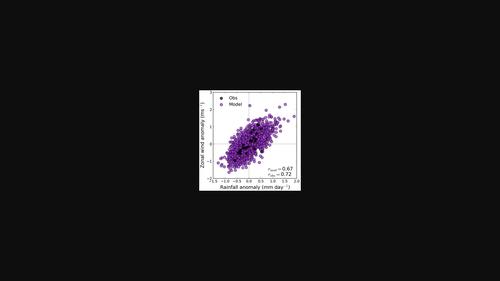当前位置:
X-MOL 学术
›
Atmos. Sci. Lett.
›
论文详情
Our official English website, www.x-mol.net, welcomes your feedback! (Note: you will need to create a separate account there.)
Predictability of the East Africa long rains through Congo zonal winds
Atmospheric Science Letters ( IF 3 ) Pub Date : 2023-08-23 , DOI: 10.1002/asl.1185 Neil Ward 1 , Dean P. Walker 1 , Richard J. Keane 1, 2 , John H. Marsham 1 , Adam A. Scaife 3, 4 , Cathryn E. Birch 1 , Ben Maybee 1
Atmospheric Science Letters ( IF 3 ) Pub Date : 2023-08-23 , DOI: 10.1002/asl.1185 Neil Ward 1 , Dean P. Walker 1 , Richard J. Keane 1, 2 , John H. Marsham 1 , Adam A. Scaife 3, 4 , Cathryn E. Birch 1 , Ben Maybee 1
Affiliation

|
East Africa is highly vulnerable to extreme weather events, such as droughts and floods. Skillful seasonal forecasts exist for the October–November–December short rains, enabling informed decisions, whereas seasonal forecasts for the March–April–May (MAM) long rains have historically had low skill, limiting preparation capacity. Therefore, improved long rains prediction is a high priority and would contribute to climate change resilience in the region. Recent work has highlighted how lower-troposphere Congo zonal winds in MAM strongly impact regional moisture fluxes and the long rains total precipitation. We therefore approach long rains predictability through the predictability of the Congo winds. We analyze a set of hindcasts from a dynamical prediction system that is able to reproduce the long rains—Congo winds relationship in its individual ensemble members. Encouragingly, in observations, the strength of MAM Congo zonal winds and East Africa rainfall show substantial correlation with the MAM Atlantic (including North Atlantic Oscillation, NAO) and Indo-Pacific variability, suggestive of ocean influence and potential predictability. However, these features are replaced by different teleconnections in the hindcast ensemble mean fields. This is also true for NAO linkage to Congo winds, despite correct representation in individual members, and good skill in hindcasting the NAO itself. The net effect is strongly negative skill for the Congo winds. We explore statistical correction methods, including using the Congo zonal wind as an anchor index in a signal-to-noise calibration for the long rains. This is considered a demonstration of concept, for subsequent implementation using models with better Congo zonal wind skill. Indeed, the clear signals found in the Atlantic (including Mediterranean) and Indo-Pacific, studied here both in observations and a dynamical prediction system, motivate evaluation of these features across other prediction systems, and offer the prospect of improved physically-informed long rains dynamical predictions.
中文翻译:

刚果纬向风对东非长雨的预测
东非极易受到干旱和洪水等极端天气事件的影响。对 10 月至 11 月至 12 月的短雨有熟练的季节性预报,可以做出明智的决策,而对 3 月至 4 月至 5 月 (MAM) 长雨的季节性预报历来技术水平较低,限制了准备能力。因此,改进长期降雨预测是当务之急,并将有助于增强该地区的气候变化抵御能力。最近的工作强调了 MAM 的对流层低层刚果纬向风如何强烈影响区域水分通量和长雨总降水量。因此,我们通过刚果风的可预测性来实现长期降雨的可预测性。我们分析了来自动态预测系统的一组后报,该系统能够在其各个集合成员中重现长降雨与刚果风的关系。令人鼓舞的是,在观测中,MAM 刚果纬向风的强度和东非降雨显示出与 MAM 大西洋(包括北大西洋涛动,NAO)和印度太平洋变率的显着相关性,表明海洋影响和潜在的可预测性。然而,这些特征被后播系综平均场中的不同遥相关所取代。NAO 与刚果风的联系也是如此,尽管个别成员的代表性正确,而且 NAO 本身在事后预测方面也有很好的技巧。刚果风的净效应是强烈的负面影响。我们探索统计校正方法,包括使用刚果纬向风作为长期降雨信噪比校准的锚定指数。这被认为是概念的演示,以便使用具有更好刚果纬向风技能的模型进行后续实施。事实上,在大西洋(包括地中海)和印度太平洋发现的清晰信号,在这里通过观测和动态预测系统进行了研究,激发了对其他预测系统对这些特征的评估,并提供了改善物理信息长降雨的前景动态预测。
更新日期:2023-08-23
中文翻译:

刚果纬向风对东非长雨的预测
东非极易受到干旱和洪水等极端天气事件的影响。对 10 月至 11 月至 12 月的短雨有熟练的季节性预报,可以做出明智的决策,而对 3 月至 4 月至 5 月 (MAM) 长雨的季节性预报历来技术水平较低,限制了准备能力。因此,改进长期降雨预测是当务之急,并将有助于增强该地区的气候变化抵御能力。最近的工作强调了 MAM 的对流层低层刚果纬向风如何强烈影响区域水分通量和长雨总降水量。因此,我们通过刚果风的可预测性来实现长期降雨的可预测性。我们分析了来自动态预测系统的一组后报,该系统能够在其各个集合成员中重现长降雨与刚果风的关系。令人鼓舞的是,在观测中,MAM 刚果纬向风的强度和东非降雨显示出与 MAM 大西洋(包括北大西洋涛动,NAO)和印度太平洋变率的显着相关性,表明海洋影响和潜在的可预测性。然而,这些特征被后播系综平均场中的不同遥相关所取代。NAO 与刚果风的联系也是如此,尽管个别成员的代表性正确,而且 NAO 本身在事后预测方面也有很好的技巧。刚果风的净效应是强烈的负面影响。我们探索统计校正方法,包括使用刚果纬向风作为长期降雨信噪比校准的锚定指数。这被认为是概念的演示,以便使用具有更好刚果纬向风技能的模型进行后续实施。事实上,在大西洋(包括地中海)和印度太平洋发现的清晰信号,在这里通过观测和动态预测系统进行了研究,激发了对其他预测系统对这些特征的评估,并提供了改善物理信息长降雨的前景动态预测。



























 京公网安备 11010802027423号
京公网安备 11010802027423号